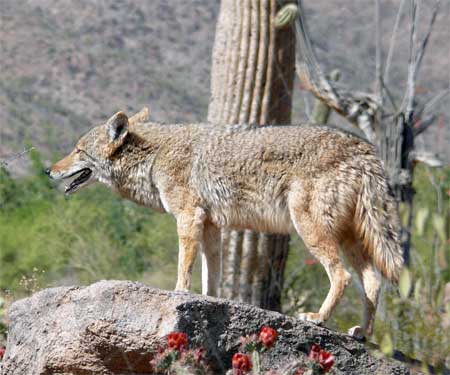BY MARGARET STEWART | DECEMBER 29, 2011

Coyote, God’s Dog
We are fortunate to have the coyote as a our foothills neighbor
To the Tohono O’ohdam people, he is a spiritual brother known as “Ban.” To the Flathead Indians of the Great Plains, he is “Sinchlep.” In Navajo lore, he is a deity, God’s dog. The ancient Aztecs gave him the name “coyotl,” which the Spanish translated into coyote.
We newcomers share the desert space with him and his family as they travel the arroyos around our homes. We see them melt into the landscape by the side of the road, and we hear them celebrating with wild choruses under the stars, but they wisely guard their secrets from us, their predators.
 The coyotes, Canis latrans, are members of the same mammal family as dogs, wolves and foxes. They are found primarily in the Midwest and Western states, and exclusively in the Western Hemisphere.
The coyotes, Canis latrans, are members of the same mammal family as dogs, wolves and foxes. They are found primarily in the Midwest and Western states, and exclusively in the Western Hemisphere.
Arizona coyotes tend to be smaller than coyotes in other parts of the country, probably due to the harsher environment. Adult males weigh around 25 pounds and have a length of over 45 inches, while females are slightly smaller. Local coyotes are gray, with a rusty shading on neck and flanks, and black at the tips of their tails.
Their food is a wide variety of animal and vegetable matter – literally whatever is easy to come by. They will scavenge at road kills and catch small animals, like mice, rabbits, pack rats and ground squirrels, helping to keep our rodent population under control. In the fall, when the pyracantha berries are ripe, we hear the coyotes bumping the walls of our house, and sometimes they leap the wall into our patio to gobble up this special treat.
Coyotes choose mates and breed in the early spring, February and March, and may form a bond that remains the rest of their lives. The pair prepares a den, hollowed out under a bush in a concealed location, for the pups which are born 60 days later. The size of the litter varies from year to year, but averages four tiny pups, whose eyes are closed for 10 to 12 days after birth.
Both parents take responsibility in their care and feeding and other adult coyotes also get involved in the elaborate training of the infants. Initially the father is responsible for feeding mom, too, as she saves her energy to produce milk for the babies. His hunting trips provide small game that is regurgitated for his stay-at-home mate. Later both parents and cooperating adult coyotes will bring solid food to regurgitate for the growing family.
If there is any threat to the cubs, real or imagined by the doting parents, a new den is dug and the family will be moved to the safer location.
When we see them in the Foothills, the coyote clan is on alert, trotting across roadways in front of our cars, moving quickly, ears at an all-business angle, ready for any trouble. At night we are introduced to their music, exotic choruses that make us marvel at their vocalizing and their harmonies. Researchers have found that their songs are efforts to locate other coyotes or news of food kills or simply rejoicing at the gathering of pack members.
A vocal warning given to infants as young as one month will result in their diving for the den and staying put for up to two hours. Hope Ryden, in her book God’s Dog, describes the effect on a litter of orphan pups of a tape of vocalizing coyotes that she had made in another state. “As the tape progressed, suddenly all six puppies dived for shelter … During the next eight minutes none made a move.” Clearly, smart coyote babies grow up understanding and obeying their parents’ language.
In the West, much effort and expense has gone into the extermination of coyotes, on both public and private lands, owing to fears by sheep and cattle ranchers and hunters that they cause the deaths of domestic or game animals. It is an emotional issue, but one that is difficult to prove. Because of their small size, coyotes are far more likely to scavenge an animal that is already dead or dying. At higher elevations, park rangers have reported that coyotes may actually starve during a winter of little snow because elk are kept healthy by plenty of browse.
And so we are fortunate to have our Foothills neighbor the coyote, God’s dog – wonderfully adapted to his environment, canny, intelligent, displaying all the family values we so admire – faithfulness, sociability, cooperation and affection for his pack. His most serious threat to us, as he goes about his business near our houses, is that he can’t tell our cats and small dogs from the other food that he brings home to feed his hungry children.
Armed with this simple knowledge and the desire to protect our pets, we, like the native peoples before us, should be able to share the Foothills with this admirable canine, the coyote.
As Thoreau wisely wrote: “This curious world which we inhabit is more wonderful than it is convenient; more beautiful than it is useful; it is more to be admired than used.”
To learn more about the coyote, check out Hope Ryden’s fascinating book, God’s Dog, at the Desert Foothills Library in Cave Creek.
COURTESY PHOTO: http://www.animalpicturesarchive.com





